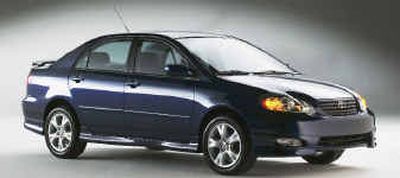Corolla adds high performance for ‘05

Only a car as utilitarian as Toyota’s Corolla could claw its way to the top of the sales heap and become the world’s best-selling vehicle.
Since its 1966 debut, the Corolla has sold more than 27 million copies in 142 countries – topping all else in the history of the automobile.
But utility tends to exact a price in excitement and if there’s been a hit on the Corolla, it has arisen from the car’s essential ordinariness.
Great car; zero sex appeal.
All that changes for 2005, though, with the introduction of the first high-performance Corolla in ages.
The new XRS is a Corolla through and through. It’s tight, solid and finished with the attention to detail that has become a Toyota hallmark.
However, under its hood beats the heart of a sophisticated, high-revving, double overhead-cam engine that can turn a daily commute into a pleasure and a day in the country into an outright rush.
And, yes, it comes fully equipped with all the goodies associated with a performance subcompact, including body extensions, spoiler, trick wheels and an audio system that plays back MP3 downloads (and will make your head hurt if you’re over 40 and find yourself needing reading glasses to decipher the works).
The XRS is the headliner among a newly revised cast of Corollas designed to fend off the well-equipped and attractively priced competitors emerging from Korea and elsewhere.
This ninth generation of Corolla was introduced in 2003 and has received substantial refreshing for ‘05. New this year is a restyled front fascia, new bumper design and grille, and new headlights and new taillights.
Buyers can choose from four trim levels: CE (from $14,220, including destination); sporty S ($15,265); LE ($15,430), and XRS ($17,995).
In times past, driving the base Corolla meant remembering how to use a manual window crank (which you needed to use, since air conditioning wasn’t part of the deal). It meant asking your passenger to adjust the passenger-side mirror, and tolerating crude, if durable, interior fabrics and an AM/FM radio – no cassette, no CD.
But, just as Toyota’s Lexus division forced Mercedes-Benz and BMW to put a cap on runaway prices, so has the competition caused Toyota to dress up even its base cars. Now, even the CE is equipped with air conditioning, AM/FM/CD stereo, power steering, power mirrors, tilt-steering wheel, exterior temperature gauge and rear-window defroster.
You still have to crank that window handle, though.
The LE adds wood-grain trim, electro-luminescent gauges, driver-seat height adjustment, remote keyless entry and, yes, power windows.
Compared with the XRS, the carry-over S trim level is a faint-hearted sportster, sharing a power train with its less flashy sibs, but adding body-color rocker panels and door handles, smoked headlights, fog lights, unique gauges and a leather-wrapped steering wheel.
The same, thrifty, 130-horsepower, four-cylinder engine powers the CE, LE and S. It’s perhaps the most refined of the entry-level fours, boasting variable valve timing and fuel economy numbers of 29/32 city and 38/40 highway, depending on whether an automatic or stick is ordered.
The XRS is an all-new trim level, and is causing some excitement in the Toyota camp, which hopes the new kid will attract buyers who otherwise would have shopped elsewhere.
It’s powered by a 170-hp version of the 1.8-liter engine that includes both variable valve timing and lift and makes 180 ponies in the Celica GT-S coupe and the Matrix XRS sport wagon.
Detuned to provide better low- and mid-range performance, the version found in the Corolla XRS is less peaky and more rewarding in everyday conditions. Peak torque of 127 pound-feet happens at 4,400 rpm, rather than 4,800 rpm as in the Celica and Matrix.
The engine is teamed with a very good, quick-shifting six-speed manual transmission (sorry, no automatic is offered) and runs best between 6,000 and 7,800 rpm. Around town, the engine provides enough low-end torque to keep things moving, but getting the most out of this engine means running it at rpm that would make other engines cower.
Others have noted the XRS seems to develop a case of the trim-rattle at high revs, but no such problem showed up in our tester.
In any case, Toyota claims 0-60 times in the mid- to high-7-second range.
The XRS has been lowered one-half inch on its chassis and coil and shock rates are increased to reduce body roll and to keep the car planted in corners, without producing the harsh ride of lesser cars.
XRS brakes are disc all around, with ABS, and seem to hold up well under abuse, with little fade when pushed hard over extended periods.
Sixteen-inch Michelin Pilot Primacy performance tires wrap around good-looking alloys and are set off by sporty, body-colored sill extensions. Those clues and a larger grille set apart the XRS from its brethren.
The interior is well designed and executed with pleasing materials. The XRS sports exceptionally comfortable performance seats, with excellent lumbar support and deep bolsters.
Fit and finish is first-class and the switchgear is Toyota-solid.
This Corolla has the same dimensions as the original Camry, which produces excellent interior room, even for rear-seat passengers and a roomy trunk.
If I could change anything about the Corolla, I’d focus on the audio controls that are too small in the high-end, MP3-capable system found in the XRS, and on the driving position, which left me sitting too far from the steering wheel.
Pricing can get steep quickly – our tester weighed in at $20,000-plus, which is a strong tariff among subcompact sedans.
Nevertheless, the Corolla XRS provides a legitimate outlet for drivers seeking the reliability, durability and resale of a Toyota but like an extra charge out of their driving experience. Good for Toyota for looking outside the comfy Corolla box.